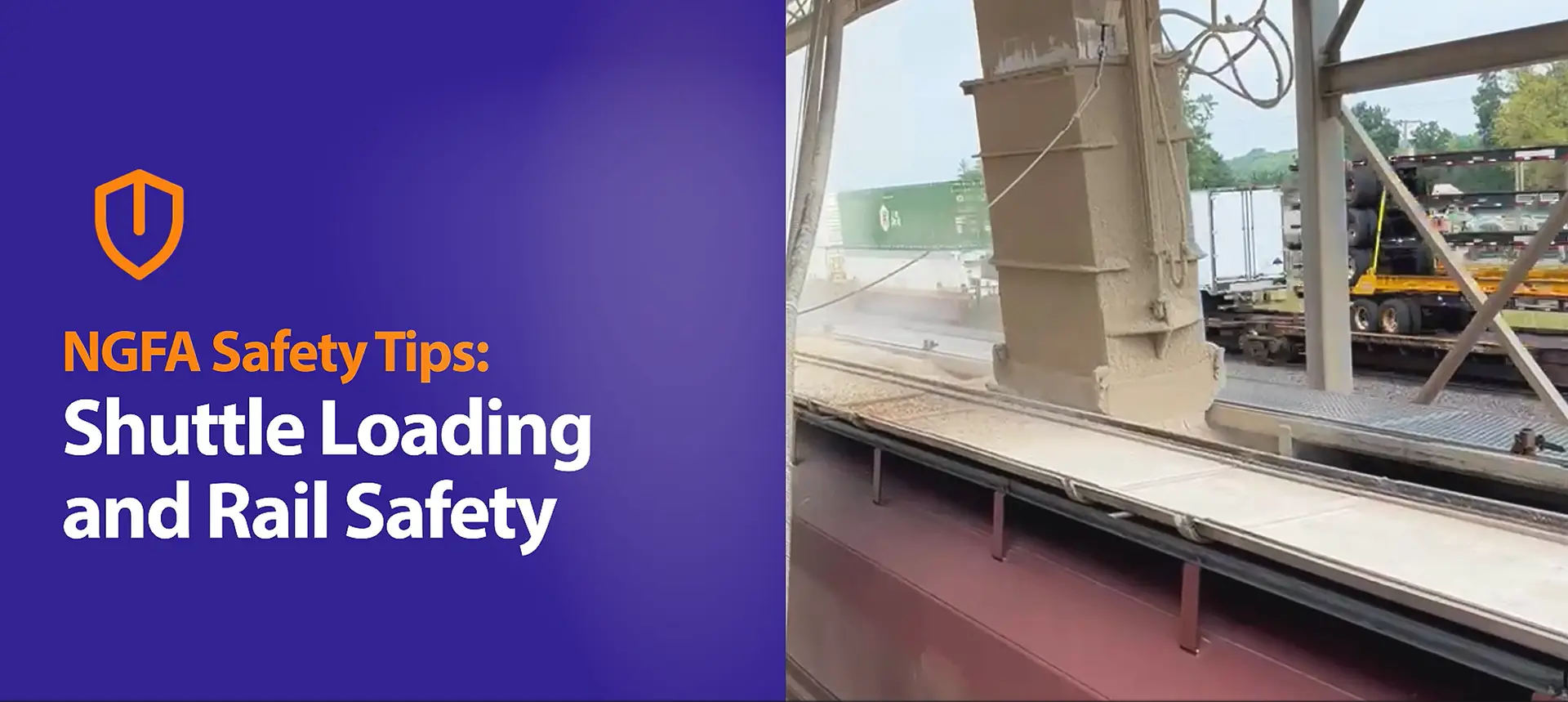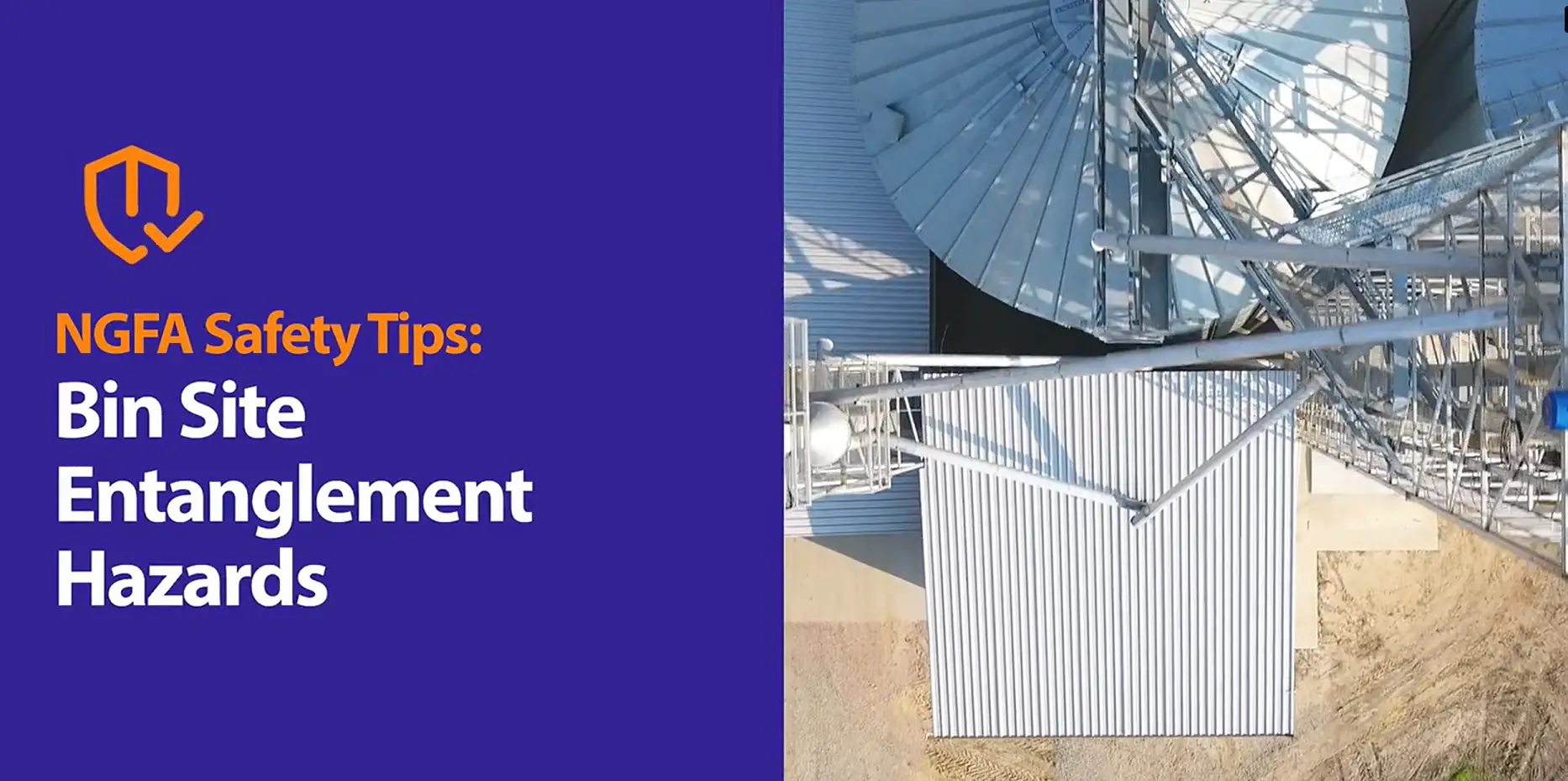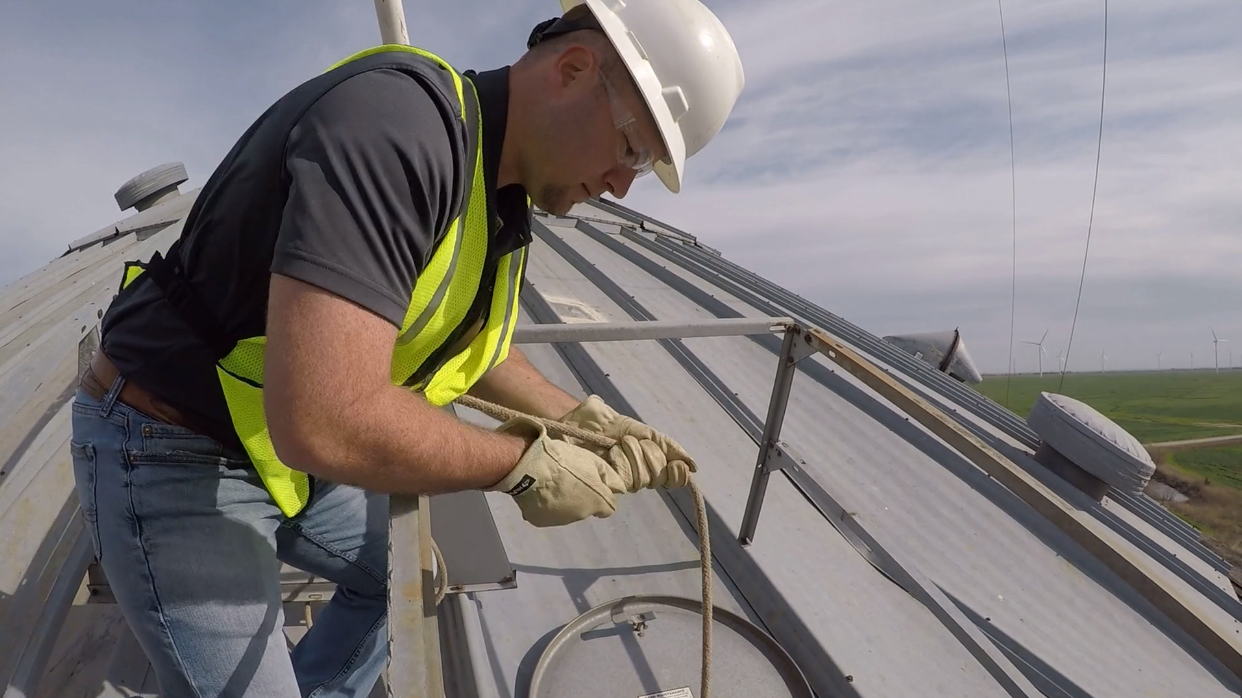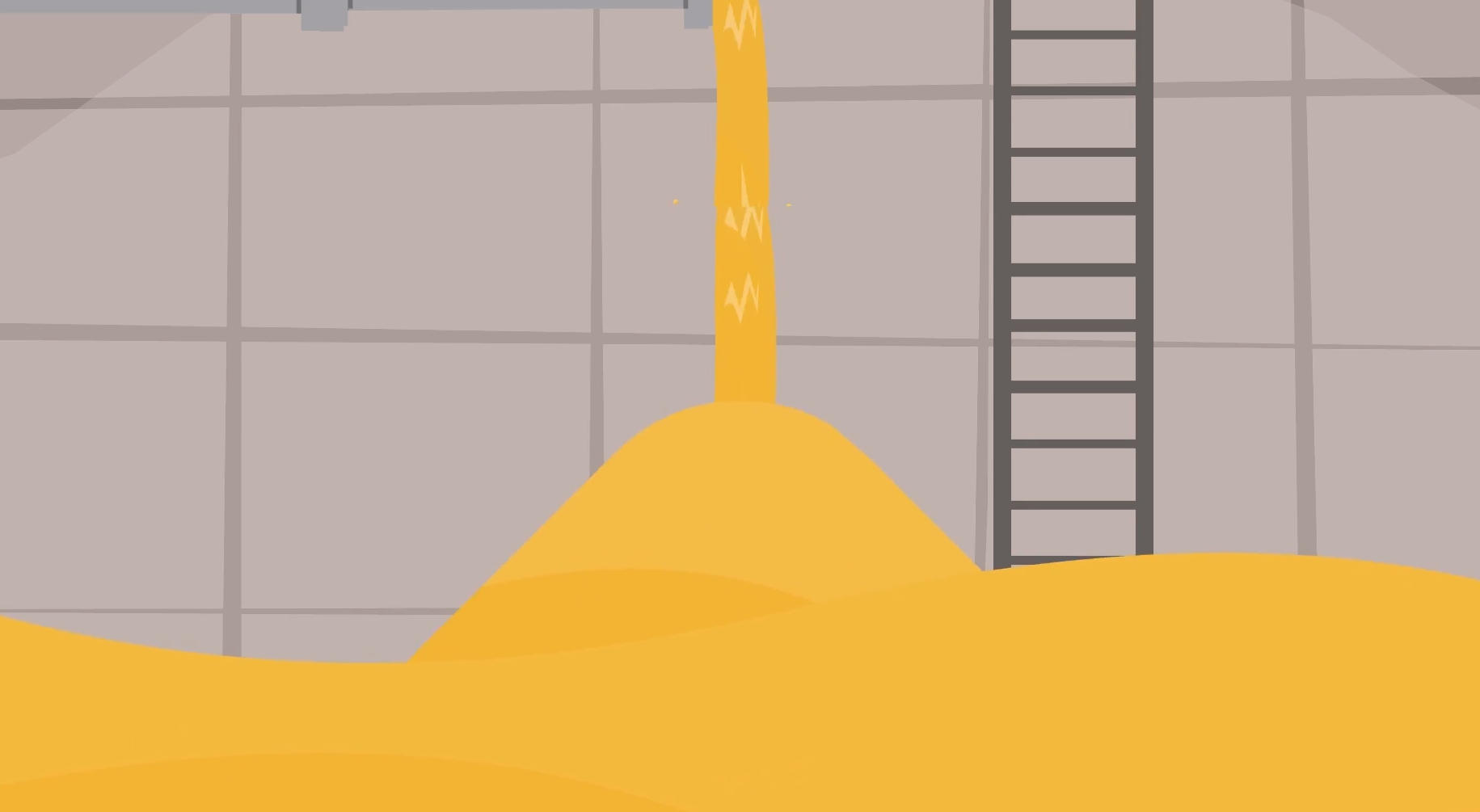SAFETY
The NGFA is committed to promoting safety and health in the workplace and shares the Occupational Safety and Health Administration’s (OSHA’s) commitment to protecting employees. Download NGFA’s “Grain Bin Safety Saves Lives” poster and letter.

Participate. Prepare. Protect.
- Safety Tips Video: Bin Site Entanglement Hazards
- Safety Tips Video: Shuttle Loading and Rail Safety
- Webinar with People Spark Consulting: Onboarding New Employees
- Presentation with M&M Specialty Services: Fumigation and IPM
@ngfa|#HarvestSafetyWeek
- Safety Tips
- Harvest Safety Week
- Webinars
- Interactive Courses
- Training Videos
- Guidance Documents
- Other Resources
The NGFA’s “Safety Tips” series is published periodically as part of the Association’s continued commitment to safety in the workplace. These documents and videos are designed to provide more information on certain types of hazards and suggested ways to protect employees through safety best practices. View each “Safety Tips” sheet below:
- Truck Dumps
- Angle of Repose Hazards
- Manlifts
- Grain Storage Piles
- Dust Suppression Techniques
- Preventing Dryer Fires
- Bin Site Entanglement Hazards
- Coronavirus Disease 2019
- Hazard Communication
- Quality Control
- Preparing Bins for Harvest
- Vehicle Struck-By
- Combustible Dust and OSHA Housekeeping Requirements
- Bulk Material Storage and Handling
- Lockout/Tagout & Energy Isolation
- VIDEO: Lockout/Tagout
- Lifting, Rigging, and Hoisting
- Hand Tool Safety
- Shuttle Loading and Rail Safety
- Trenching and Excavation Safety
- Heat- and Cold-Related Injuries
- Emergency Action Plan
- Proper Glove Selection
- Hot Work
- Powered Industrial Trucks
- NGFA Alert: Powered Industrial Trucks vs. Skid-Steer Loaders
2024
- Safety Tips Video: Bin Site Entanglement Hazards
- Safety Tips Video: Shuttle Loading and Rail Safety
- Webinar with People Spark Consulting: Onboarding New Employees
- Presentation with M&M Specialty Services: Fumigation and IPM
2023
- Safety as a Workplace Value – NGFA members discuss what valuing safety means to them in their working environments.
- Evolution of Safety in Grain Handling – NGFA members discuss how attitudes toward safety have shifted during their careers in agriculture.
- Harvest Hazards – NGFA members discuss harvest hazards and safety best practices.
- Hazard Identification Methods – Dawn Moninger, EHS director at J.D. Heiskell & Co., discusses serious to simple proactive hazard identification methods.
2022
- Welcome Video on Heat Injury/Illness
- OSHA Heat Injury and Illness NEP Presentation – Representatives from OSHA’s Directorate of Standards and Guidance and Directorate of Enforcement Programs discuss the status of the Heat Injury and Illness National Emphasis Program in a recorded presentation. Jess McCluer, NGFA’s vice president of safety and regulatory affairs, summarizes OSHA’s pending heat injury and illness standard.
- NGFA Member Best Practices Discussion – In this recorded panel discussion, NGFA members Jason Eardley, ADM; Paul Gooch, CGB; Brian Grimm, Bartlett and Company; and Rob Grabowski, George’s Inc., discuss their companies’ heat-related policies and best practices.
- Legal Expert Webinar – Aaron Gelb, partner at Conn Maciel Carey LLP, discusses OSHA’s Heat Injury and Illness National Emphasis Program (NEP).
2021
- Transforming Workplace Safety Culture – Video with People Spark Consulting and NGFA members
- Bin Harvest Prep with Marie Dinwiddie – Podcast
- Struck-By Hazards with Mark Trainor – Podcast
- Critical Pieces of Equipment with Jarrod Nickelson – Podcast
- Dryer Operations with David Noel – Podcast
NGFA Safety Webinars hosted by Joe Mlynek, founder of Progressive Safety Services, LLC, and partner at Safety Made Simple:
Accountability – April 10, 2024
Coming soon:
Hazardous Atmospheres in Confined Spaces – June 18
Serious Injury and Fatalities (SIFs) in the Grain and Feed Industry – Nov. 14
The NGFA-produced “Training Modules” through Articulate 360 are published periodically as part of the Association’s continued commitment to safety in the workplace. These modules are funded by the National Grain and Feed Foundation and are designed to provide information on certain types of hazards and best safety practices within the grain handling and feed industry. Check here often to find new, relevant and interactive content.

Articulate 360 Training Module: Slips, Trips, and Falls
Articulate 360 Training Module: Lockout/Tagout
Combustible Dust Safety

The most recent safety training video funded by the National Grain and Feed Foundation outlines important housekeeping procedures and identifies potential ignition sources for combustible dust. Watch now.
Safety and Grain Quality
 Working in or around a grain bin exposes farmers and workers to serious and life-threatening hazards, including entrapment and suffocation from engulfment. This video, funded by the National Grain and Feed Foundation, illustrates the connection between grain quality and safety. Watch now.
Working in or around a grain bin exposes farmers and workers to serious and life-threatening hazards, including entrapment and suffocation from engulfment. This video, funded by the National Grain and Feed Foundation, illustrates the connection between grain quality and safety. Watch now.
Grain Bin Entry Safety
 NGFA Director of Safety, Education, and Training Jim Seibert reviews the basic safety precautions and equipment needed to enter a grain bin. This short video, funded by the National Grain and Feed Foundation, breaks down each step of the process to ensure managers and employees don’t miss a step and stay safe every day. Watch now.
NGFA Director of Safety, Education, and Training Jim Seibert reviews the basic safety precautions and equipment needed to enter a grain bin. This short video, funded by the National Grain and Feed Foundation, breaks down each step of the process to ensure managers and employees don’t miss a step and stay safe every day. Watch now.
Your Safety Matters
Developed jointly by the NGFA and Grain Elevator and Processing Society (GEAPS), this safety training DVD is geared specifically to employees of grain handling, feed manufacturing and grain processing operations. The 30-minute DVD, which also is available in Spanish, addresses many safety-related issues, including confined space safety. Members: Watch Download Non-members: Watch Download
Grain Bin Safety on the Farm
The National Corn Growers Association and the National Grain and Feed Foundation (NGFF) – the NGFA’s research and education arm – completed a joint DVD project to promote grain bin safety on the farm. Preview the video for more information.
Don’t Go With the Flow
Developed in 1998 by Purdue University under a contract with the NGFF, this program reviews the hazards associated with flowing grain and the most common types of grain entrapments at commercial facilities. Preview the video for more information. (Order Form)
- This Firefighting Manual contains information for operators of grain handling facilities and firefighters on emergency and firefighting procedures. The contents of the manual are primarily intended to address planning for and fighting fires in grain elevators. However, the information has significant applications for feed mills, processing plants, flour mills and other facilities that store and handle bulk agricultural commodities. Chemical fires also are addressed briefly, which has applications for fertilizer and chemical plants.
NGFA Guidance Document for Compliance with OSHA Update to Subpart D Walking-Working Surfaces
- This guide provides a basic overview of the changes made to the general industry standards addressing slip, trip, and fall hazards found in Subpart D of the Occupational Safety and Health Administration (OSHA) standards. The guide is meant to serve as a foundation upon which individual companies can build their own tailored plans specific to their facility, operations, personnel, and other conditions. Sample documents found in the appendices provide templates that may be used to update site-specific programs and procedures.
Overview of OSHA Final Rule on Electronic Reporting
On July 2023, OSHA issued a final amended E-Recordkeeping Rule that will take effect on January 1, 2024. OSHA intends for March 2, 2024, to be the first submission deadline for the latest information required to be submitted under this rule. Specifically, OSHA is amending its regulation to require establishments with 100 or more employees in certain designated industries to electronically submit information from their OSHA Forms 300 and 301 to OSHA once a year. Establishments with 20 to 249 employees in certain industries will continue to be required to electronically submit information from their OSHA Form 300A annual summary to OSHA once a year. All establishments with 250 or more employees that are required to keep records under OSHA’s injury and illness regulation will also continue to be required to electronically submit information from their Form 300A to OSHA on an annual basis. Grain, feed, processing and milling facilities that employ between 20-249 employees are required to submit the OSHA Form 300A annually and those with more than 100 employees are also required to submit OSHA forms 300 and 301 annually.
OSHA Hazard Communication Guide
- NGFA and the American Feed Industry Association released a hazard communication compliance guide for consideration and use by grain handling, feed, ingredient and processing facilities. With a June 1 implementation deadline approaching for compliance with major elements of the Occupational Safety and Health Administration’s recently revised Hazard Communication Standard (HCS), the associations created the document to ensure the industry is prepared for updated compliance requirements. For more information, download the free, nearly 50-page document.
- Please note – If you share the document, please include the following information: “This document is distributed with the permission of the National Grain and Feed Association, the American Feed Industry Association, the Corn Refiners Association and the North American Millers Association.” We also ask that the credit include the name of the publication and the publication date (e.g., “The document Guidance: Hazard Communication Program at Grain Handling, Feed, Ingredient & Processing Facilities was originally published in May 2015”).
- For more information, see the recorded webinar where experts from the organizations highlighted recent changes and provided answers to members’ most frequently asked questions.
Permit Required Confined Space/Boot Pit Evaluation Guide for Grain Elevators
- NGFA prepared a guidance document to assist grain handling facilities in evaluating their boot pits to determine whether they meet OSHA’s definition of permit-required confined spaces.
Guidance for Sweep Auger Operations in Grain Bins
- This guide provides basic concepts to assist grain handling facilities in developing and implementing a sweep auger operations safety policy.
Below you’ll find links to other great resources from members and partners who share the commitment to safety:
The NGFA’s extensive efforts to enhance safety include unprecedented research and education efforts launched in the early 1980s that helped lead to a dramatic reduction in the number of fire and explosion incidents in commercial grain-handling facilities in the late 1970s. The industry has demonstrated its commitment, before and after the promulgation of the OSHA’s grain handling standard, 29 CFR 1910.272, in 1988.
The U.S. Department of Labor’s Occupational Safety and Health Administration (OSHA) and the National Grain and Feed Association (NGFA) formed an alliance, which will allow the grain, feed and processing industry to work more closely and collaboratively with the regulatory agency. Learn more on the Alliance page.
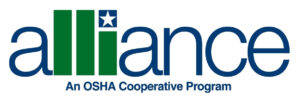
OSHA currently has emphasis programs that apply to grain, feed, and processing facilities within the jurisdiction of all Regions V, VI, VII, VIII and X Area OSHA Offices. Based on these programs, inspections will primarily focus on the six major hazard areas of engulfment, falls, auger entanglement, struck by, combustible dust explosions andelectrocution.
- Past Projects
- Current Projects
National Fire Protection Association Study
A significant increase in costs and loss of overall storage capacity for both concrete and steel bins were the findings of recent study on the application of the National Fire Protection Association’s (NFPA) explosion/deflagration venting requirements per latest editions of NFPA 68 – Standard on Explosion Protection by Deflagration Venting. The NFPA standards are commonly used in North America (Canada, United States and Mexico) as the basis for determining if explosion venting is required and if so, the total amount of vent area required.
This study was financed by the National Grain and Feed Foundation and was conducted by the engineering firm Van Sickle, Allen and Associates in Minneapolis, Minn. The NFPA briefly considered conducting a research study to determine appropriate venting ratio data for silos utilized for storing agricultural commodities, including grains and oilseeds. The NFPA research was intended to follow up on one conducted through the NGFA’s Fire and Explosion Research Program in 1983. However, the NFPA Foundation ultimately decided not to pursue new research.
For more information, see an Executive Summary on the report.
To order a full copy of the 90-page study, the cost is $250 for non-NGFA members and $100 for NGFA members, contact Jess McCluer, NGFA vice president of safety and regulatory affairs.
More information to come.
Recent articles, press releases and issue advisories on safety and health issues can be found here.

